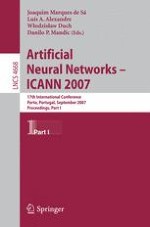2007 | Buch
Artificial Neural Networks – ICANN 2007
17th International Conference, Porto, Portugal, September 9-13, 2007, Proceedings, Part I
herausgegeben von: Joaquim Marques de Sá, Luís A. Alexandre, Włodzisław Duch, Danilo Mandic
Verlag: Springer Berlin Heidelberg
Buchreihe : Lecture Notes in Computer Science
